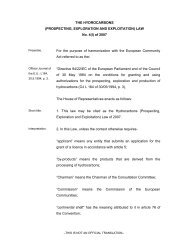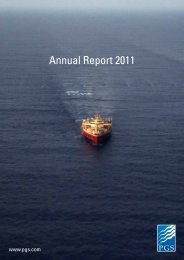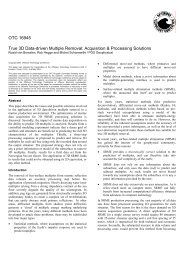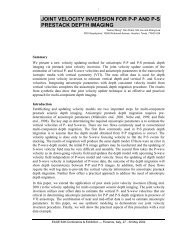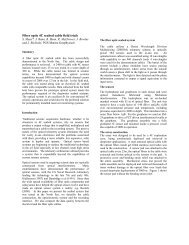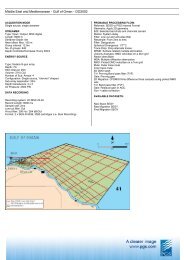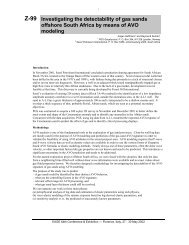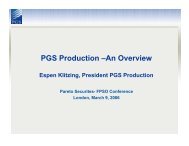A strategy for anisotropic P-wave prestack imaging - PGS
A strategy for anisotropic P-wave prestack imaging - PGS
A strategy for anisotropic P-wave prestack imaging - PGS
You also want an ePaper? Increase the reach of your titles
YUMPU automatically turns print PDFs into web optimized ePapers that Google loves.
1<br />
A <strong>strategy</strong> <strong>for</strong> <strong>anisotropic</strong> P-<strong>wave</strong> <strong>prestack</strong><br />
<strong>imaging</strong><br />
RUBEN D. MARTINEZ AND SHENG LEE<br />
<strong>PGS</strong> Geophysical, 10550 Richmond Ave., Houston, Texas 77042<br />
Summary<br />
The <strong>prestack</strong> depth <strong>imaging</strong> process has been and is continuously evolving with the goal of<br />
accurately position the seismic events in space. To achieve this goal, the <strong>prestack</strong> <strong>imaging</strong><br />
process should account <strong>for</strong> anisotropy. If the presence of anisotropy is important, then<br />
ignoring it will have a significant impact in the final <strong>imaging</strong> accuracy. In this paper, we<br />
restrict our discussion to vertical transverse isotropy (VTI) or polar anisotropy.<br />
We propose a <strong>strategy</strong> that combines <strong>anisotropic</strong> <strong>prestack</strong> time and depth <strong>imaging</strong>. The<br />
<strong>strategy</strong> consists of a <strong>prestack</strong> time migration <strong>for</strong> V(z) and VTI media loop from which the<br />
effective <strong>anisotropic</strong> (Vnmo and η eff ) parameters are estimated as a function of two-way time.<br />
The <strong>strategy</strong> continues with the conversion of the effective <strong>anisotropic</strong> parameters to interval<br />
parameters as functions of depth. Then, the depth <strong>imaging</strong> loop is executed, here the interval<br />
<strong>anisotropic</strong> parameters are iteratively refined until the final image is obtained.<br />
The <strong>strategy</strong> proposed here provides stability to the <strong>anisotropic</strong> <strong>prestack</strong> <strong>imaging</strong> process.<br />
This stability comes from the fact that the <strong>anisotropic</strong> parameters are first estimated using a<br />
time migration which in turn become the initial parameters <strong>for</strong> the depth <strong>imaging</strong> steps.<br />
Introduction<br />
Several methodologies to per<strong>for</strong>m <strong>anisotropic</strong> <strong>prestack</strong> <strong>imaging</strong> have appeared in the<br />
literature. The key <strong>for</strong> a successful <strong>anisotropic</strong> <strong>imaging</strong> is the estimation of the <strong>anisotropic</strong><br />
parameters. Some approaches rely on in<strong>for</strong>mation based on the geologic knowledge of the<br />
area from which appropriate values <strong>for</strong> the <strong>anisotropic</strong> parameter, η, are assumed. In other<br />
cases, a simple constant value <strong>for</strong> η is assumed <strong>for</strong> the area and the output quality is judged<br />
based on the observed ‘image quality’. Adjustments to the velocities and η are typically<br />
achieved iteratively. But a systematic approach is desired to properly constrain the parameter<br />
estimation and obtain accurate subsurface images. Figure 1 shows a flow chart which<br />
describes the main steps of the <strong>strategy</strong> proposed in this contribution.<br />
Anisotropic time <strong>imaging</strong>.<br />
The first step in our <strong>strategy</strong> is to per<strong>for</strong>m <strong>prestack</strong> time migration <strong>for</strong> V(z) and VTI media<br />
(see Fig.1). This migration approach accounts <strong>for</strong> the ray bending caused by the vertical<br />
velocity variation with depth and VTI. At least two migration iterations are required to<br />
EAGE 64th Conference & Exhibition — Florence, Italy, 27 - 30 May 2002
2<br />
Amplitude Preserving<br />
Kirchhoff Pre-stack<br />
Time Migration<br />
<strong>for</strong> V(z) and VTI<br />
Anisotropic Ray<br />
Tracing <strong>for</strong> P<br />
Waves<br />
• NMO Velocity model vs<br />
time<br />
• η eff model vs time<br />
•Interval Velocity model vs depth<br />
•Interval η model vs depth<br />
•Vertical velocity model vs depth<br />
Controlled<br />
Amplitude<br />
Kirchhoff Prestack<br />
•Sonic logs<br />
•Check shots<br />
•VSP<br />
• Adjust Velocity model in depth<br />
• Adjust Interval η model in depth<br />
Fig.1 Main steps <strong>for</strong> the proposed <strong>anisotropic</strong> <strong>prestack</strong> <strong>imaging</strong> <strong>strategy</strong>.<br />
estimate the effective parameters; NMO velocities and effective η. The criteria to decide the<br />
best estimation is when the best focusing (gathers are flat in time) is achieved.<br />
The final results of this step are: an image that is superior to that obtained using a straight ray<br />
<strong>prestack</strong> time migration and the effective velocities (NMO) and η estimated during the<br />
process. The accuracy of the NMO velocities should be very useful to estimate interval<br />
velocities to be used in the initial iteration of <strong>prestack</strong> depth migration. Figure 2 shows an<br />
example of a NMO velocity field and the corresponding effective η estimated in this step<br />
using field seismic data.
3<br />
(a)<br />
(b)<br />
Fig.2 (a) Interval velocity field (meters per second in the legend) versus two-way time derived<br />
from the effective time migration velocities; (b) effective η parameter (effective η x 1000 in<br />
the legend) versus two-way time. Both the interval velocities and effective η were smoothed<br />
along layers.<br />
Anisotropic parameters <strong>for</strong> depth <strong>imaging</strong><br />
While <strong>prestack</strong> time migration <strong>for</strong> V(z) and VTI media requires two effective parameters<br />
(Vnmo and η eff ), <strong>prestack</strong> depth migration requires three. These parameters are: interval<br />
velocities (estimated from multichannel seismic data)(V i ), interval vertical velocity (Vo i ) and<br />
the interval <strong>anisotropic</strong> parameter (η i ). In our <strong>strategy</strong> (see Fig.1), we propose to compute V i<br />
and η i versus depth from the effective parameters Vnmo and η eff versus two-way time using<br />
the familiar Dix equation <strong>for</strong> V i and a Dix-type <strong>for</strong>mulation <strong>for</strong> η i . The parameter Vo i has to<br />
be estimated with help from borehole data, i.e. sonic logs, check shots or zero offset VSP’s.<br />
Anisotropic Depth <strong>imaging</strong><br />
Once the interval parameters are calculated from the <strong>prestack</strong> time migration results, the first<br />
iteration of depth migration is per<strong>for</strong>med. The three interval parameters are used to build<br />
gridded volumes to per<strong>for</strong>m <strong>anisotropic</strong> ray tracing to generate the traveltimes required <strong>for</strong><br />
Kirchhoff depth migration (see Fig.1). The interval <strong>anisotropic</strong> parameters are adjusted at<br />
every depth migration iteration until the ‘best’ focusing (gathers are flat in depth).<br />
To illustrate the difference between isotropic and <strong>anisotropic</strong> depth <strong>imaging</strong>, Figure 3 shows<br />
the results obtained after depth migration. A slight image improvement in the salt flank is<br />
observed in the <strong>anisotropic</strong> depth <strong>imaging</strong> result (2 kms)(Fig.3(b)). But more importantly, the<br />
deep seismic horizons apperar at different depths. The isotropic depth <strong>imaging</strong> produces<br />
deeper horizons than those obtained when VTI is accounted <strong>for</strong> during depth migration. This<br />
EAGE 64th Conference & Exhibition — Florence, Italy, 27 - 30 May 2002
is particularly clear <strong>for</strong> the strong event at 4 kms. (black arrows). This depth differences are<br />
mainly driven by the velocities V i and Vo i and are related to the <strong>anisotropic</strong> parameter δ.<br />
4<br />
(a)<br />
(b)<br />
Fig.3 Results obtained with isotropic (a) and <strong>anisotropic</strong> (b) depth <strong>imaging</strong>.<br />
Conclusions.<br />
The proposed <strong>strategy</strong> provides a stable means <strong>for</strong> <strong>anisotropic</strong> <strong>prestack</strong> <strong>imaging</strong> and<br />
<strong>anisotropic</strong> parameter estimation. First, the effective parameters are estimated through<br />
<strong>prestack</strong> time migration (Vnmo, η eff ) and the process continues with the refinement of the<br />
parameters (V i , Vo i , and η i ) through <strong>anisotropic</strong> depth migration. The estimated velocities are<br />
accurate after time migration due to the ray bending allowed in the algorithm to account <strong>for</strong><br />
V(z) and VTI. The depth <strong>imaging</strong> loop benefit from this velocity accuracy by assuring a<br />
reliable initial model and there<strong>for</strong>e reducing the number of iterations necessary to achieve the<br />
final result. Another important point to remark is that isotropic <strong>prestack</strong> <strong>imaging</strong> should<br />
always be accomplished prior to the <strong>anisotropic</strong> equivalent <strong>for</strong> best results.<br />
Acknowledgements<br />
We would like to thank our colleagues Min Lou and Shelton Ma from <strong>PGS</strong> Research and DPS<br />
respectively <strong>for</strong> providing the processing software <strong>for</strong> the <strong>anisotropic</strong> parameter estimation<br />
and <strong>anisotropic</strong> ray tracing stages of the <strong>strategy</strong>.



